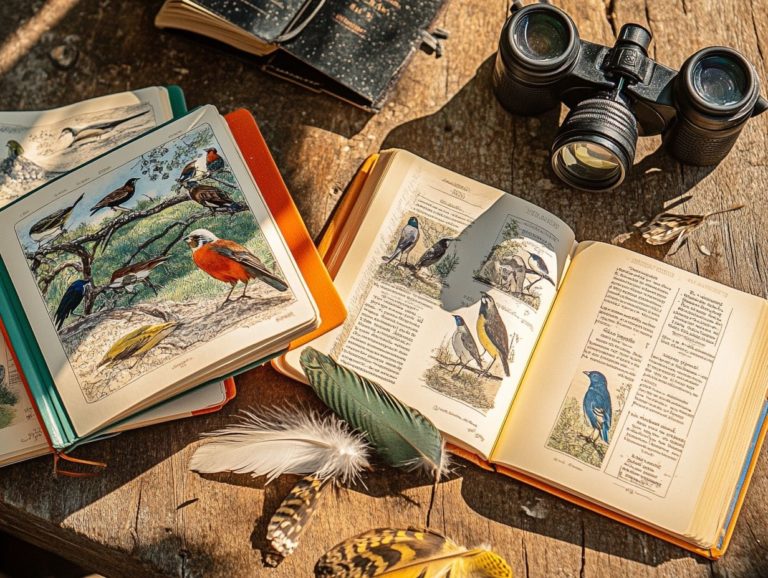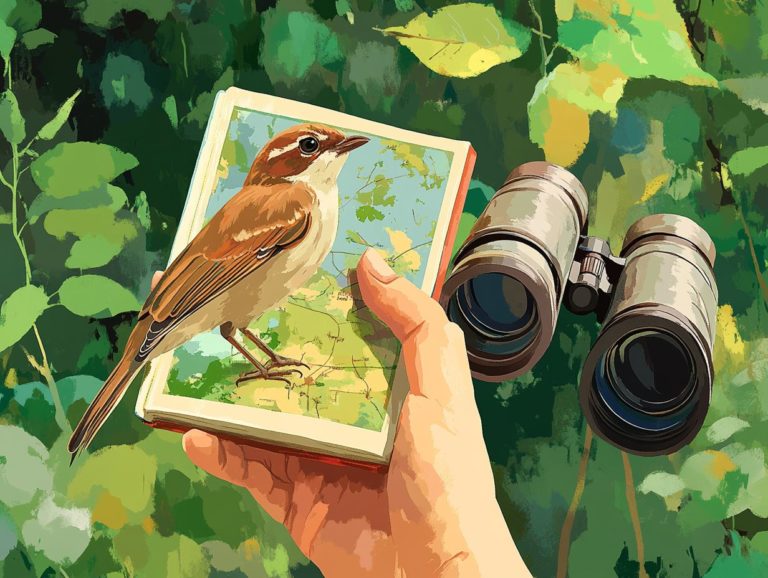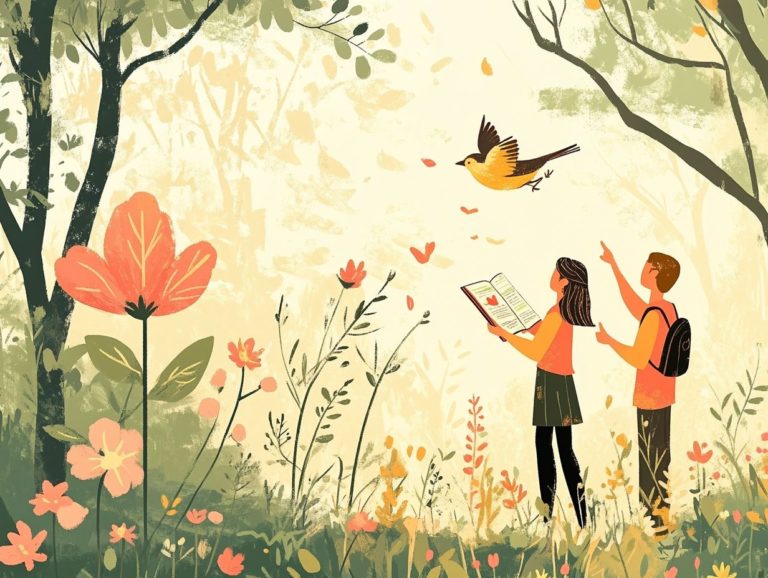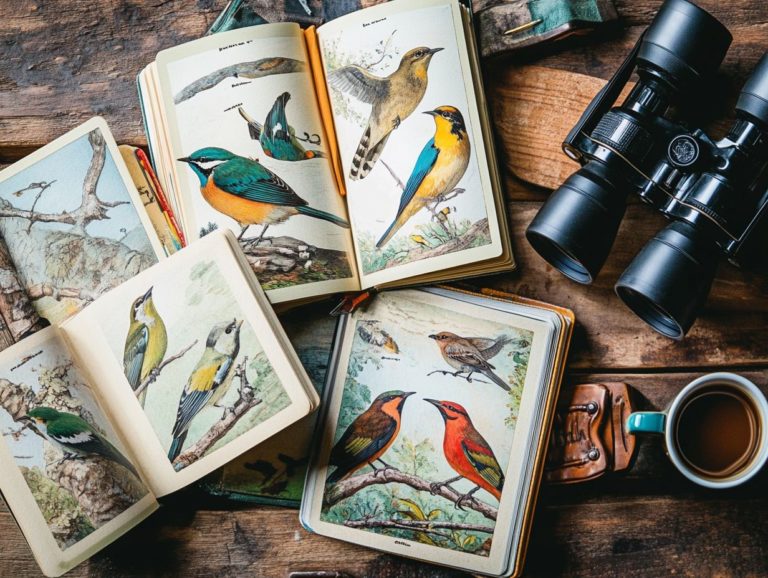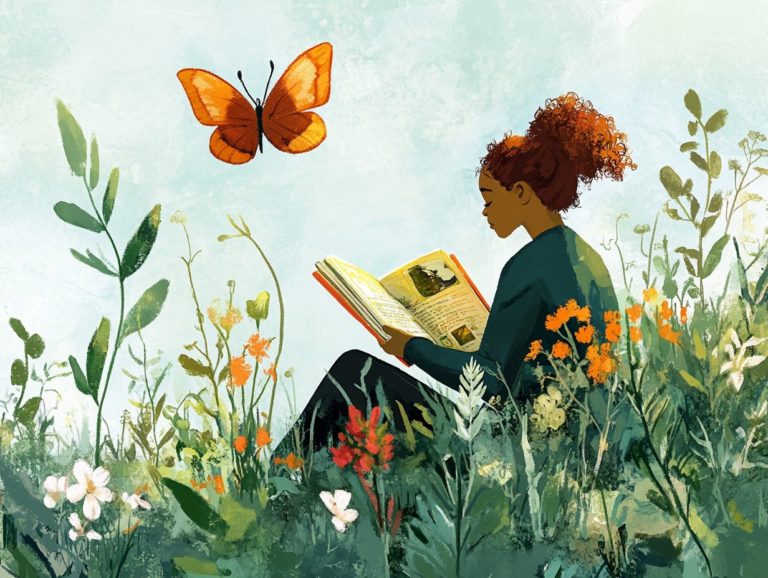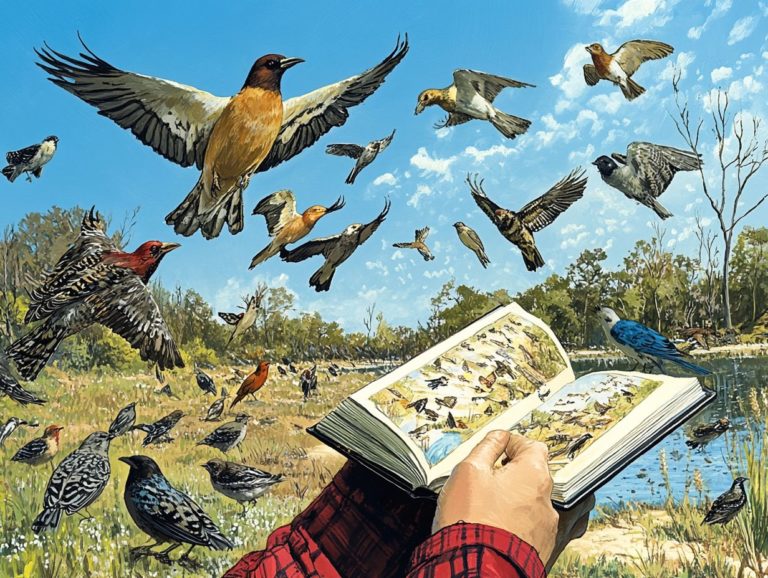Field Guides for Birding Events and Local Meetups
Birding is soaring in popularity, captivating enthusiasts of all ages.
Whether you re a seasoned birdwatcher or just starting your journey, this guide offers essential tips to enhance your experience at birding events and local meetups.
From grasping the fundamentals of birding to preparing for outings and selecting the right gear, you ll uncover valuable insights.
Dive into practical advice on bird identification, safety, etiquette, and the vital conservation efforts that support this passionate community.
Embark on this adventure as you explore the vibrant world of birding!
Contents
- Key Takeaways:
- 1. Discover Birding: What Makes It So Popular?
- 2. How to Prepare for a Birding Event or Local Meetup
- 3. Essential Gear for Birding
- 4. Tips for Identifying Birds in the Field
- 5. Safety Precautions for Birding
- 6. Etiquette for Birding Events and Local Meetups
- 7. Common Birds to Look Out For
- 8. How to Document Your Birding Experience
- 9. Benefits of Joining a Birding Group or Club
- 10. How to Find Birding Events and Local Meetups
- 11. Resources for Learning More About Birds
- 12. How to Get Involved in Bird Conservation Efforts
- 13. Birding Destinations Around the World
- 14. Frequently Asked Questions About Birding Events and Local Meetups
- 15. Final Thoughts and Recommendations
- Frequently Asked Questions
- 1. What are field guides and why are they important for birding events and local meetups?
- 2. Where can I find reliable field guides for birding events and local meetups?
- 3. Are there different types of field guides available?
- 4. Can I use a field guide on my phone or tablet?
- 5. What should I look for when choosing a field guide for a birding event or local meetup?
- 6. Can I contribute to field guides for birding events and local meetups?
Key Takeaways:
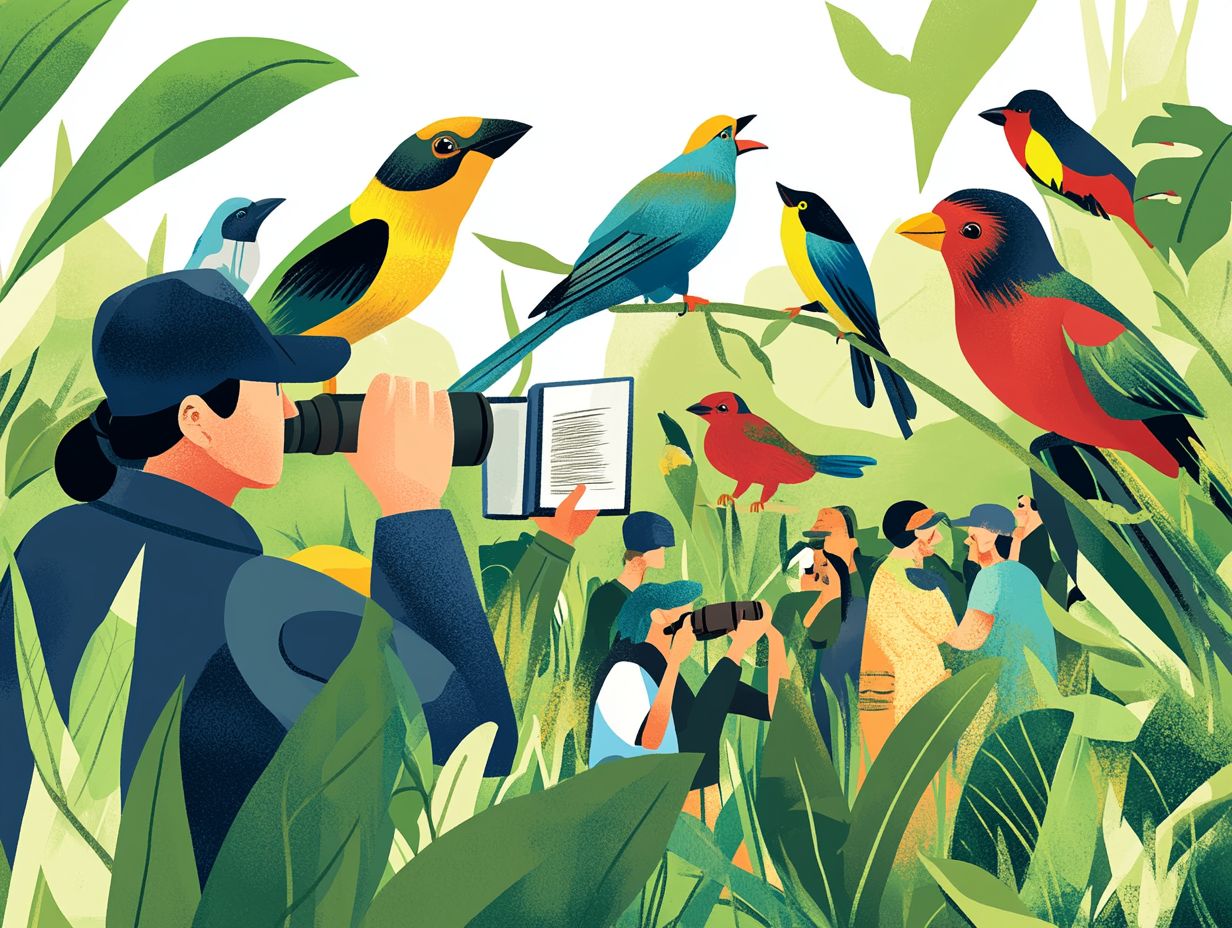
- Birding connects you with nature and various bird species.
- Preparation, gear, and safety are vital for a rewarding experience.
- Joining a birding group fosters community and conservation efforts.
1. Discover Birding: What Makes It So Popular?
Birding, often seen as an exciting outdoor activity, has surged in popularity thanks to its remarkable blend of adventure, education, and conservation.
It appeals to those like you who yearn to explore diverse wildlife habitats and deepen their connection with nature through the art of bird identification and observation.
This pastime has transformed from a special interest into a lively community, partly due to the rise of numerous birding clubs and festivals that cultivate camaraderie among enthusiasts.
These gatherings offer you a chance to exchange knowledge with fellow birdwatchers and emphasize the importance of protecting migratory birds and their habitats.
When you join local bird projects, you help collect data that helps scientists understand bird populations, reinforcing conservation efforts. This educational aspect makes your birding experience more fulfilling and fosters a profound sense of stewardship toward wildlife and environments that often go unnoticed.
2. How to Prepare for a Birding Event or Local Meetup
Preparing for a birding event or local meetup is crucial for maximizing your experience, especially when you’re joining small groups led by experienced leaders or participating in birding tours in hotspots like Austin, Texas. Utilizing local birdwatching events and resources can enhance your knowledge and enjoyment.
Start by exploring local birding clubs and events that frequently organize field trips or workshops tailored to various skill levels, and consider checking out this guide on how to host a field guide birdwatching group.
Engaging with fellow bird enthusiasts in these clubs will provide you with invaluable insights into the best times and locations for spotting unique species.
Understanding the specific wildlife habitats you’ll visit will further enrich your appreciation for each bird s behaviors.
Creating a detailed checklist of essential items like binoculars, field guides, and snacks will ensure you re well-prepared and ready for the adventure.
A comprehensive pre-tour briefing can equip you with valuable tips on bird identification and etiquette, setting the stage for an unforgettable experience in nature.
3. Essential Gear for Birding
Having the right essential gear for birding is crucial to elevate your adventures. It ensures that you can confidently identify species and savor high-quality tours in comfort.
Among the essential items, a pair of quality binoculars truly stands out, allowing you to observe distant birds with remarkable clarity while keeping your feathered friends undisturbed.
Field guides specifically tailored for bird identification can significantly expand your knowledge, offering valuable insights into the habits and habitats of various species.
Appropriate clothing is equally vital; breathable, weather-resistant fabrics enhance your mobility while shielding you from the elements.
If you re passionate about capturing stunning images, investing in reliable photography gear becomes essential.
When selecting your equipment, consider the specific birding environments you intend to explore different locales may necessitate specialized gear to truly optimize your experience.
Don’t wait! Grab your binoculars and step into the captivating world of birding today!
4. Tips for Identifying Birds in the Field
Successfully identifying birds in the field demands a blend of sharp observation, dedicated practice.
It requires solid knowledge, especially when exploring birding hotspots under the expert guidance of seasoned leaders during guided walks.
This journey begins with a meticulous examination of physical traits such as size, color, and unique markings. Observing behaviors like feeding habits, flight patterns, and social behavior can unveil crucial clues to a bird s identity.
Vocalizations are equally important; mastering the art of recognizing various calls and songs undoubtedly enhances your ability to pinpoint those elusive species. Leveraging field guides and smartphone apps can greatly streamline your learning experience, providing invaluable images and sounds for comparison.
Fostering patience and committing to consistent practice is essential. While developing your birding skills may take time, the rewards of immersive experiences in nature are well worth the effort.
5. Safety Precautions for Birding
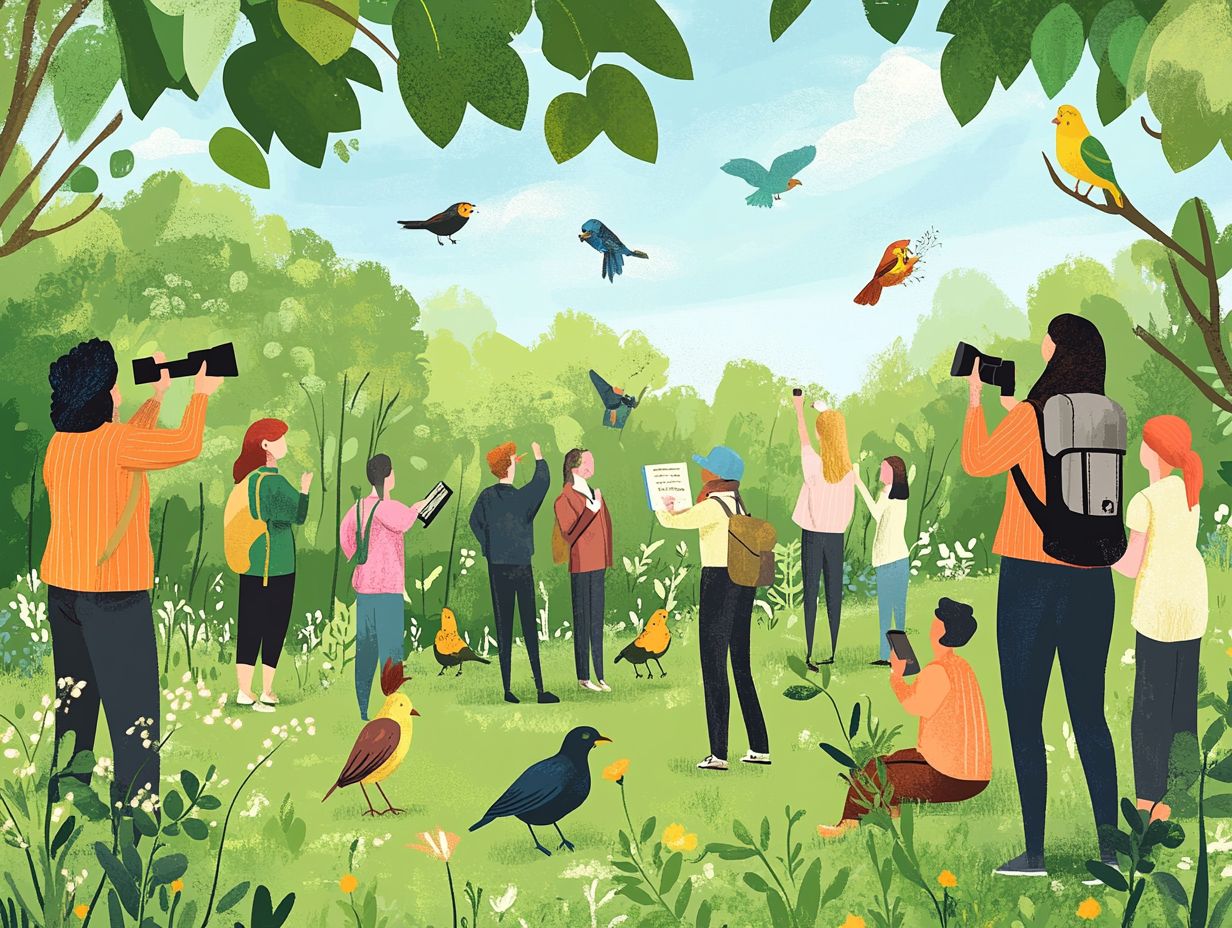
When you participate in birding events, it’s essential to adhere to safety precautions that safeguard both your well-being and the wildlife habitats you re exploring, particularly during community science activities.
Staying aware of your surroundings is crucial; it helps you avoid potential hazards while minimizing disturbances to the birds. Protect yourself from the elements by wearing the right clothing for changing weather or applying sunscreen. This will enhance your experience without compromising your safety.
Respecting wildlife is paramount; observe from a distance and resist the urge to feed or approach them, as this can disrupt their natural behaviors. In community science, prioritize safety by organizing with a group, using reliable tools for data collection, and educating fellow participants about respectful observing practices.
This thoughtful approach not only enriches your experience but also nurtures a sustainable relationship with nature.
6. Etiquette for Birding Events and Local Meetups
Understanding and practicing proper birding etiquette at events and local meetups is crucial for creating a warm, enjoyable atmosphere among fellow birders while ensuring a respectful experience for the birds and their habitats. Utilizing field guides for birdwatching can also enhance your experience.
This involves adhering to essential practices, such as maintaining a respectful silence and keeping a safe distance from nesting birds, which significantly reduces stress for these creatures. Sharing spotting scopes can elevate everyone’s experience and foster camaraderie among participants.
It’s equally important to respect the guidance of experienced leaders and club members, as their insights can profoundly enhance your outing. Being courteous and inclusive not only nurtures a sense of community but also transforms your birding adventure into a more enjoyable and fulfilling journey.
Join us in making every birding outing memorable for everyone involved!
7. Common Birds to Look Out For
Get ready for an exciting birding adventure where you’ll discover amazing feathered friends! Knowing which common birds to keep an eye out for can truly elevate your experience, especially in popular hotspots where you might spot gems like the Eastern Bluebird, Hyacinth Macaw, and Ross’s Gull.
Along with these striking birds, you can also seek out the vibrant Cardinals and playful Chickadees that often grace backyards and parks. In Austin, the Great Blue Heron typically resides near lakes and wetlands, making it a must-see for those willing to wander the waterside trails.
Meanwhile, Louisiana’s lush bayous offer ideal habitats for the majestic Roseate Spoonbill, easily recognized by its stunning pink plumage. You ll find observing these avian wonders most rewarding during the early morning hours or late afternoon when they are at their most active especially around their nesting sites or feeding grounds.
Don t miss your chance to spot the stunning Eastern Bluebird and more! It s wise to bring along binoculars and a field guide to enhance your spotting and identification skills.
8. How to Document Your Birding Experience
Documenting your birding experiences is fulfilling. It plays a crucial role in bird identification and community science.
By keeping a birding journal, you can record essential details about your sightings, such as dates, locations, and species observed. This practice enriches your personal knowledge and becomes a valuable resource for local birding clubs. Using bird identification apps can elevate your experience, enabling you to match your observations with images and calls quickly, ensuring accurate records.
Capturing photographs allows you to immortalize the beauty of each bird, creating lasting memories while providing valuable documentation for conservationists. These efforts strengthen bonds among birders and deepen your commitment to bird conservation initiatives, making a meaningful impact on local habitats.
9. Benefits of Joining a Birding Group or Club
Joining a birding group or club opens up a world of benefits, from engaging in community science projects to accessing exclusive birding festivals. It s a fantastic way to connect with fellow enthusiasts who share your passion for bird conservation and birding tours.
These clubs also offer great networking opportunities. You can exchange tips, stories, and experiences with others. By participating in organized birding tours with experienced leaders, you’ll explore various wildlife habitats and discover diverse avian species alongside knowledgeable guides.
If you’re in Austin, Texas, you ll find the Travis Audubon Society hosting regular guided outings and educational programs for all skill levels. In Louisiana, the Louisiana Ornithological Society facilitates exciting events like the Big Sit and Christmas Bird Count. They also provide essential resources like Field Guides and connections with local experts, enriching your overall birding experience.
10. How to Find Birding Events and Local Meetups
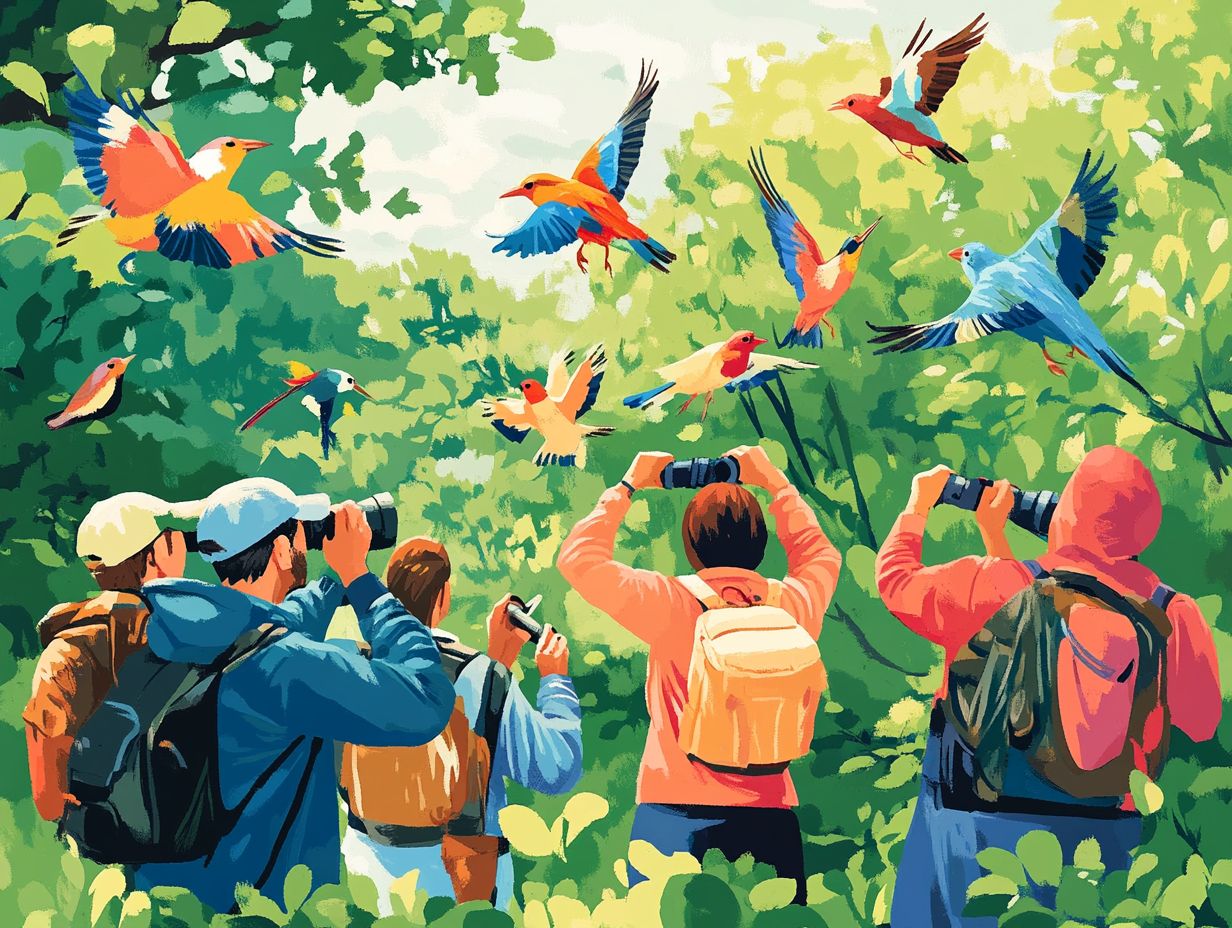
Finding birding events will take your birding experience to new heights! You can connect with community science initiatives and join local birding clubs that celebrate the wonders of avian observation, while also exploring field guides to build your birdwatching knowledge.
To dive deeper into this enriching realm, numerous online platforms are at your fingertips, guiding you toward your next adventure. Websites like eBird and the Audubon Society provide detailed event listings tailored to various locations and interests, including Louisiana birding hotspots. Social media platforms, like Facebook and Instagram, prove invaluable, as local birders frequently share event information and personal sightings.
Birding clubs often announce their gatherings and festivals through newsletters or community boards, warmly inviting newcomers to engage in a birding adventure. By participating in these events, you cultivate a deeper appreciation for birds and forge friendships while fostering collaborative conservation efforts within the community, including local chapters focused on restoration and education, as well as utilizing field guides: essential tools for bird conservation.
11. Resources for Learning More About Birds
To deepen your understanding of birds and elevate your birding skills, a treasure trove of resources awaits you. This includes Field Guides, online courses, and local birding clubs that offer invaluable insights into bird identification and behavior.
Many enthusiasts swear by the Peterson Field Guide series. This series provides detailed illustrations and descriptions for North American birds, including the Eastern Bluebird and Hyacinth Macaw. With mobile apps like Merlin Bird ID and iBird Pro at your fingertips, identifying birds by their sounds and visual features has never been easier just pull out your phone.
Websites such as All About Birds and the Audubon Society are goldmines of rich articles and videos. They explore various aspects of bird behavior and conservation, including migration patterns and tips for visiting birding hotspots.
You can also take online courses on platforms like Coursera and Udemy. These courses equip you with techniques to recognize different species and their habitats.
Joining local birding clubs helps you build a sense of community. It also allows for firsthand experiences and knowledge sharing that can truly enhance your birding journey through guided bird walks and other community events.
12. How to Get Involved in Bird Conservation Efforts
Getting involved in bird conservation efforts is a meaningful way to contribute to the preservation of bird species and their habitats. There are numerous opportunities available through birding clubs and community science initiatives such as the Great Backyard Bird Count.
One effective method is volunteering with local chapters of conservation organizations like the Baton Rouge Audubon Society. Here, you can lend your time and skills to habitat restoration projects or educational programs.
Participating in citizen science activities, which are community projects where everyday people help gather scientific data, allows you to collect valuable data that directly influences conservation strategies.
You can support dedicated organizations through donations or by attending events like Birdfest. This plays a crucial role in funding various projects aimed at protecting birds and their ecosystems.
By choosing to engage in these actions, you can make a tangible difference in the fight for bird conservation. Join us today in protecting our feathered friends! Every action counts.
13. Birding Destinations Around the World
Get ready for an adventure! Exploring birding destinations across the globe reveals unique treasures waiting to be discovered. Each locale presents unparalleled opportunities for birding tours, captivating enthusiasts from every corner of the world through private tours with warm, fun-loving guides.
Take Costa Rica, for instance. Its rich biodiversity lures bird watchers with dazzling quetzals and resplendent hummingbirds flitting through the trees.
Meanwhile, the wetlands of the Everglades in Florida are alive with herons and egrets, creating a vibrant scene. The Amazon Basin stands as a true hotspot for birders, where the incredible variety of avian species offers a visual feast.
This makes it a favored choice among eco-tourists and birding adventures. Don t overlook the renowned Gal pagos Islands; their endemic species provide a fascinating glimpse into the process of evolution.
Many of these extraordinary locations offer guided tours and guided bird walks. This allows both novices and seasoned birders to immerse themselves in the experience and learn from expert ornithologists who provide insights into bird identification.
14. Frequently Asked Questions About Birding Events and Local Meetups
Addressing frequently asked questions about birding events and local meetups can make you feel more comfortable and informed about how to identify birds, the latest birding hotspots, etiquette, and what to expect from your birding experience. Utilizing field guides can also help bridge knowledge gaps in your birding journey.
By guiding you on what essentials to pack like binoculars, Field Guides, and some tasty snacks and suggesting ways to find and connect with local birding clubs, you ll gain insights that can truly enhance your journey. Sharing simple tips for identifying birds, such as recognizing specific markings, sounds, and behaviors of species like Ross’s Gull, will empower you as a beginner.
Participating in these gatherings not only helps you forge friendships with fellow enthusiasts but also fosters a sense of community among groups like the Crescent Bird Club and Gulf Coast Bird Club. This enriches your overall adventure in exploring the avian world.
15. Final Thoughts and Recommendations
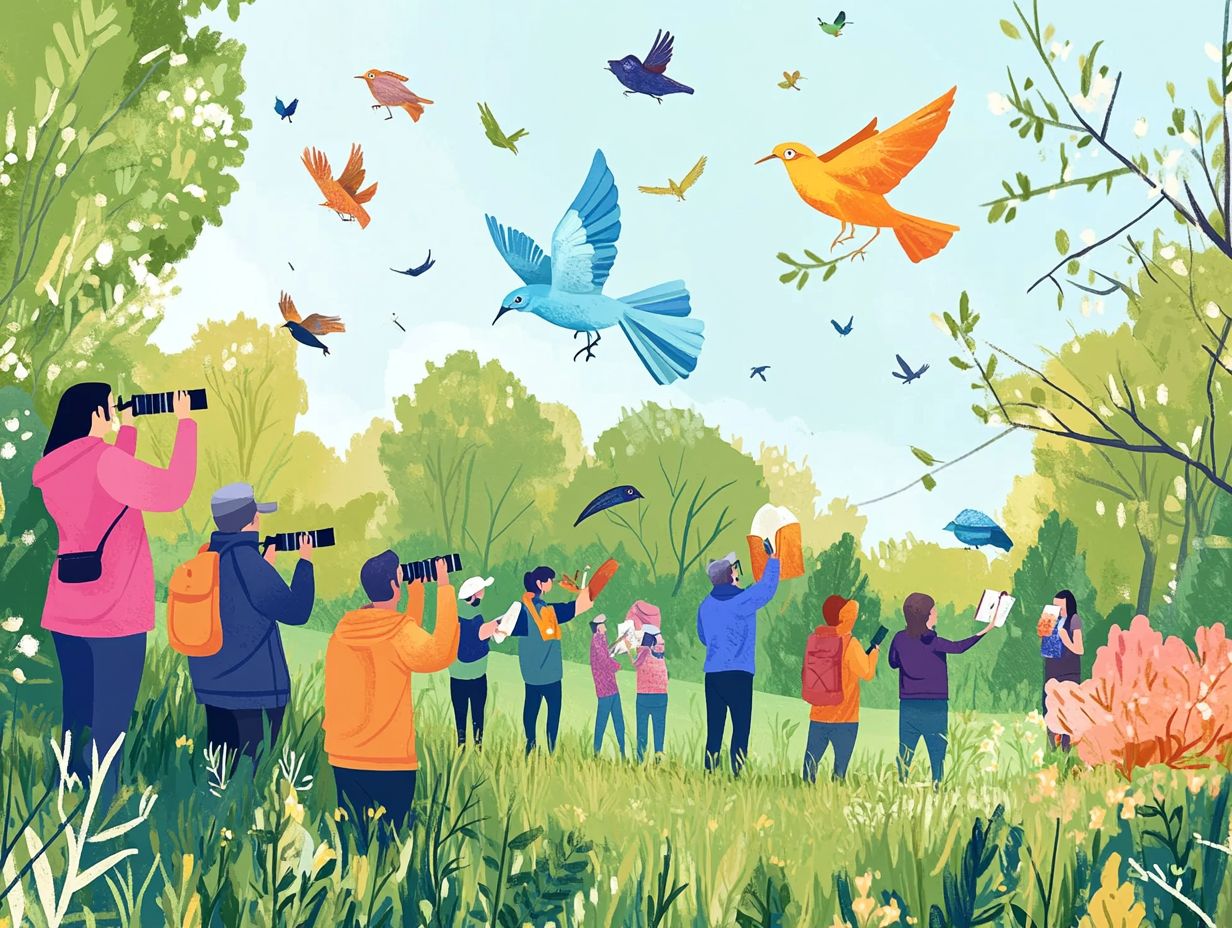
Embracing the world of birding can usher you into rewarding adventures and a deeper connection with nature. Dive into the world of local birding clubs such as the Louisiana Bayou Bluebird Society and participate in birding festivals to truly enrich your experience.
These communities cultivate friendships among fellow nature enthusiasts while offering invaluable insights and resources about bird species, migration patterns, and habitat conservation, especially in regions like Austin, Texas. By joining these clubs, you ll have the chance to learn from seasoned birders and participate in guided outings that sharpen your observational skills.
Birding festivals celebrate the beauty and diversity of avian life, providing workshops, lectures, and opportunities to engage with experts from organizations like the American Birding Association. As you delve into this captivating hobby, it s essential to remain mindful of environmental protection, ensuring that future generations can also revel in the wonders of birdwatching.
Frequently Asked Questions
1. What are field guides and why are they important for birding events and local meetups?
Field guides are reference books that contain information and illustrations of different bird species, including the Eastern Bluebird and Hyacinth Macaw. They are essential for birding events and local meetups, and using field guides: a beginner’s companion to birding can help participants identify and learn about the birds they encounter.
2. Where can I find reliable field guides for birding events and local meetups?
You can find Field Guides at most bookstores, outdoor recreation stores, or online retailers. You can also borrow them from your local library or birding club.
3. Are there different types of field guides available?
Yes, there are different types of Field Guides available, ranging from regional guides to specific species guides. Some Field Guides also include additional information such as bird behavior, habitats, and migration patterns.
4. Can I use a field guide on my phone or tablet?
Yes, there are many digital field guide apps available for smartphones and tablets. These can be convenient for birding events and local meetups as they are easy to carry and often have additional features such as bird call recordings. Utilizing field guides to enhance your birdwatching experience can further enrich your outings.
5. What should I look for when choosing a field guide for a birding event or local meetup?
When choosing a Field Guide, look for one that is specific to the region or location you will be birding in, such as Austin, Texas or Louisiana. Ensure it has clear and detailed illustrations or photos, and includes a key or index for easy navigation. For a comprehensive resource, consider checking out field guides for bird conservation.
6. Can I contribute to field guides for birding events and local meetups?
Yes, many Field Guides are created with contributions from amateur birders and experts alike. You can submit your sightings and photographs to organizations such as the Orleans Audubon Society or websites that produce field guides, or even create your own guide for a specific region or species.
Ready to explore? Join a local birding event or meetup today!

